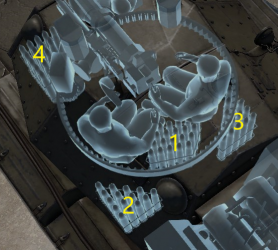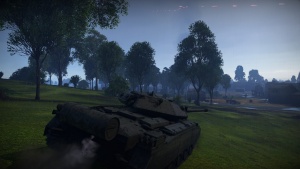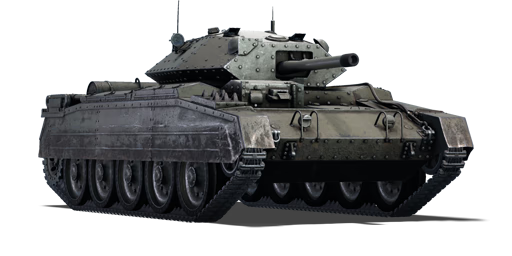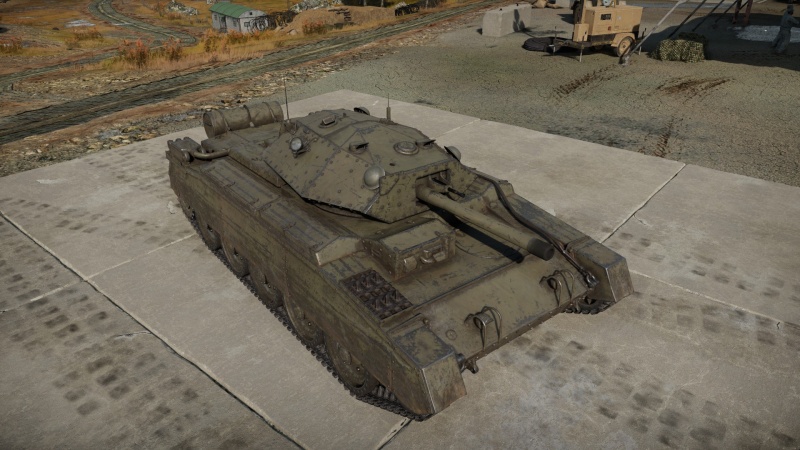Crusader III
| This page is about the British light tank Crusader III. For other uses, see Crusader (Family). |
Contents
Description
The Tank, Cruiser, Crusader III (A15) is a rank II British light tank with a battle rating of 3.0 (AB/RB/SB). It was introduced along with the initial British tree line in Update 1.55 "Royal Armour".
The low-profile Crusader is amongst the first light tanks on the British tech tree with the ability to perform scouting, which is a much relevant role amidst battles.
Although classified as a light tank, the Crusader is only light because of the low armour. Nor the speed or the gun fit in this light category, since the 57 mm 6-pounder is very efficient and in many regards, better than the previous 40 mm 2-pounder found on the Crusader II. This translates into decent firepower capable of engaging most tanks by the front. Yet the same early engine now underpowered struggles with the new heavier cannon, bringing the total weight from 16 tons in the earlier Crusader Mk II now to over 20 tons. Thus the performance of fast attacks or quick flanking manoeuvres is somewhat impeded by this low-power to weight ratio.
Despite these shortcomings, the vehicle should be a more uncomplicated and easy to learn playstyle than similar ranked vehicles as the slow advancing Valentine or Matildas.
General info
Survivability and armour
Like the previous Crusader II, the Crusader III's armour is just like other common light tanks. The hull fron glacis is only 20mm which is not enough to stop pretty much any round unless angled at an extreme. The most noticeable difference is the absence of the MG turret next to the driver, which directly exposes the unsloped hull armour behind, reducing its sturdiness. The hull side is ~30mm which can deflect some low-penetrating rounds when angling, but generally it is still very weak. The turret front loses the huge rounded gun mantlet of the Crusader II. Although it now looks cleaner and uncluttered, the flat 30mm armour becomes trully untrustworthy against any vehicle as it simply cannot bounce anything now. The turret side is sloped but thin, at 14mm it will not stop any shell unless the shell happens to hit a heavily angled part. Overall the Crusader III has poor armour protection and can only resist MG bullets and some autocannon shells. Even lots of SPAAs (eg. Wirbelwind, M15 CGMC, etc) can penetrate it frontally.
The post penetration survivability is a lot worse than the Crusader II. Because of the lack of MG turret, the MG gunner is also gone, leaving only 3 crew members, 2 of which are closely packed inside the turret. At this BR there will be a lot more vehicles using explosive-packed shells (eg. M24, Pz.IV F2, Chi-Nu, T-34 1942, etc) and they will easily penetrate the Crusader III and wipe out all the crew. Make use of your smoke grenades when neeeded to increase your low survivability.
Armour type:
- Rolled homogeneous armour
- Cast homogeneous armour (Gun mantlet, Driver's port)
- Structural steel (Side skirts)
| Armour | Front | Sides | Rear | Roof |
|---|---|---|---|---|
| Hull | 20 mm (33°) Front plate 9 mm (78-85°), 20 mm (61°) Front glacis 20 mm (26-64°) Lower glacis |
4 + 14 + 14.27 mm | 14 mm (44-50°) Top (14-52°) 14 mm Bottom |
7 mm |
| Turret | 31.75 mm (1°) Turret front 30 mm (0-44°) Gun mantlet |
14 mm (50°) | 17 mm (28-53°) | 12.7 mm |
Notes:
- Suspension wheels and tracks are 15 mm thick.
- Interior 14.27 mm side armour is made of rolled homogeneous armour.
Mobility
| Game Mode | Max Speed (km/h) | Weight (tons) | Engine power (horsepower) | Power-to-weight ratio (hp/ton) | |||
|---|---|---|---|---|---|---|---|
| Forward | Reverse | Stock | Upgraded | Stock | Upgraded | ||
| Arcade | 47 | 8 | 20.3 | 527 | 649 | 25.96 | 31.97 |
| Realistic | 43 | 7 | 301 | 340 | 14.83 | 16.75 | |
Modifications and economy
Armaments
Main armament
| 57 mm 6pdr OQF Mk.III | Turret rotation speed (°/s) | Reloading rate (seconds) | |||||||||||
|---|---|---|---|---|---|---|---|---|---|---|---|---|---|
| Mode | Capacity | Vertical | Horizontal | Stabilizer | Stock | Upgraded | Full | Expert | Aced | Stock | Full | Expert | Aced |
| Arcade | 65 | -12°/+20° | ±180° | Shoulder | 34.3 | 47.4 | 57.6 | 63.7 | 67.8 | 5.20 | 4.60 | 4.24 | 4.00 |
| Realistic | 21.4 | 25.2 | 30.6 | 33.8 | 36.0 | ||||||||
Ammunition
| Penetration statistics | |||||||
|---|---|---|---|---|---|---|---|
| Ammunition | Type of warhead |
Penetration @ 0° Angle of Attack (mm) | |||||
| 10 m | 100 m | 500 m | 1,000 m | 1,500 m | 2,000 m | ||
| Shot Mk.5 | AP | 101 | 97 | 82 | 66 | 53 | 43 |
| Shot Mk.5 HV | AP | 108 | 104 | 87 | 70 | 57 | 46 |
| Shot Mk.8 | APC | 110 | 106 | 89 | 72 | 59 | 48 |
| Shot Mk.9 | APCBC | 122 | 118 | 101 | 84 | 70 | 58 |
| Shell Mk.10 | HE | 9 | 9 | 9 | 9 | 9 | 9 |
| Shell details | |||||||||
|---|---|---|---|---|---|---|---|---|---|
| Ammunition | Type of warhead |
Velocity (m/s) |
Projectile Mass (kg) |
Fuse delay (m) |
Fuse sensitivity (mm) |
Explosive Mass (TNT equivalent) (g) |
Ricochet | ||
| 0% | 50% | 100% | |||||||
| Shot Mk.5 | AP | 815 | 2.8 | N/A | N/A | N/A | 47° | 60° | 65° |
| Shot Mk.5 HV | AP | 853 | 2.8 | N/A | N/A | N/A | 47° | 60° | 65° |
| Shot Mk.8 | APC | 853 | 2.87 | N/A | N/A | N/A | 48° | 63° | 71° |
| Shot Mk.9 | APCBC | 801 | 3.23 | N/A | N/A | N/A | 48° | 63° | 71° |
| Shell Mk.10 | HE | 655 | 2.72 | 0 | 0.1 | 590 | 79° | 80° | 81° |
Ammo racks

| Full ammo |
1st rack empty |
2nd rack empty |
3rd rack empty |
4th rack empty |
Visual discrepancy |
|---|---|---|---|---|---|
| 65 | 46 (+19) | 31 (+34) | 16 (+49) | 1 (+64) | No |
Optics
| Crusader III Optics | ||
|---|---|---|
| Default magnification | Maximum magnification | |
| Main Gun optics | x1.9 | x3.5 |
| Comparable optics | AMR.35 ZT3 | |
Machine guns
| 7.92 mm BESA | ||||
|---|---|---|---|---|
| Mount | Capacity (Belt) | Fire rate | Vertical | Horizontal |
| Coaxial | 3,375 (225) | 600 | N/A | N/A |
Usage in battles

The Crusader tank was designed to be fast and highly mobile, exploiting gaps in enemy battle lines by penetrating the flanks and disrupting the enemy from behind. In the game, the Crusader should be used in a similar fashion. It is quick, well armed and highly manoeuvrable, making it great at rushing capture points and exploiting the enemies flanks. The 57 mm gun is excellent for its tier, with high penetration and good ballistics. Very few tanks can withstand a hit from this gun without major damage. When uptiered, it is a good sneaky flanker in later rank matches with the gun being still effective.
The tank's low profile is its main advantage. You can hide easily among vegetation and obstacles like walls, shooting from a concealed position or retreating under smoke if the situation is looking a little too dangerous.
Of course, you can't have everything. The tank has thin armour, so it isn't suitable as a front line tank unless in a supporting role. The armour is sloped on some areas, so you may bounce some smaller calibre shells. Explosive shells are your worst nightmare, so avoid getting hit by them. The 57 mm gun has great penetration, but the Crusader has very thin armour. There are still plenty of enemies that can give you some trouble.
While the battle is about staying alive in the tank, do not forget about the allies. This Crusader is a great support tank, not just in firepower, but is also capable of scouting and repairing for the team.
In recap, preferably play as a faster medium tank in a support role amidst the frontline during early module research, additionally players can act as flankers and either eliminate the threats themselves or scout the enemy tanks for allies in SPGs or Strike Aircraft.
- Enemies worth noting
- T-34 (1940) - You will begin encountering early models of T-34s at this tier. You can penetrate their turret easily and drivers port easily, but they can pose a serious problem when angled properly. Also, the 76 mm L-11 gun can easily take you out with its massive explosive power. Try to take out the gunner first and then deal with the rest of the crew members for a safe kill.
- Pz.IV F1 - The rapid-fire 75 mm short barrelled gun can fire HEAT or APCBC rounds, which can penetrate and cause serious damage to the Crusader. Luckily, the F1 has flat armour which can be easily penetrated from the front. Range is your friend with these tanks. Their gun is very difficult to aim accurately over 500 m. Hit it before it hits you and you will most likely come out on top.
- Pz.IV F2 - You may have to face off against the dreaded Panzer IV F2. Its gun is accurate, high penetration and causes massive damage upon penetration. It will kill you easily at range. Fortunately, it has the same weak flat armour as the F1, so can be easily dealt with if you get off the first shot
- KV-1 (L-11) - These heavy tanks are rare at your battle rating, but can still be faced. They have great, bouncy armour and a deadly gun. Try to hit the turret cheeks or the side/rear armour.
- Pz.III L - This Panzer III has a great, high-velocity gun and excellent frontal armour. The extra 20 mm high hardness plates make a massive difference to the frontal armour, making it more bouncy and harder to penetrate. Fortunately, your gun can reliably penetrate the Panzer III L. If you are unsure, aim for the drivers port to kill the driver, gunner and commander.
Almost every tank can kill you easily, even with Rank I guns. Stay mobile or hidden, take advantage of the tanks low profile and shoot only when you know you can penetrate. This can make you a formidable tank on the battlefield.
Pros and cons
Pros:
- Low profile acts as first way of protection
- Lethal semi-stabilized and also quick firing gun; capable of fighting higher rank vehicles as ▀T 34 747 (r), Pz.Bef.Wg.IV J or ▀KV-IB
- Armour is thin but has odd angles, causing some rounds to bounce
- Reverse speed is much better than the Cromwell chassis, though still only average
- Good manoeuvrability
- Carries 50 smoke grenades, can lay down long smoke screens to cover allies on large areas
Cons:
- Low power to weight ratio; not as fast as other light tanks at this rank
- Weak armour overall, turret is flat and easily pierced by most guns at the rank
- Only 3 crew members, relatively easy to kill in one shot
History
Development
In 1938, the General Staff of the British Army requested for a cruiser tank that was lighter and more affordable than the heavier A16 cruiser design developed by Nuffield Mechanizations & Aero. One of these designs was the designation Tank, Cruiser Mk.V based off the A13 cruiser tanks, named the "Covenanter", and Nuffield was invited to become part of its development team, but they refused due to interest in developing their own cruiser tank. Their tank was designated the Tank, Cruiser Mk.VI Crusader and fell under the General Staff specification of A15. The Crusader was a parallel design to the Covenanter but was ready six weeks earlier than the Covenanter despite starting at a later time. The Crusader was adopted into service with the British Army in 1941 and the 5,300 units were manufactured between 1940 to 1943.
Design
The Crusader features a new design that differs from its cruiser tank predecessors. The Christie suspension system on the Crusader had five road wheels for it instead of the usual four, which improves weight distribution of the increased 20-ton weight of the Crusader compared to the 14 tons of the A13 cruisers. The engine, steering system, and cooling system on the Crusader was different as well, but the Covenanter and Crusader use the same main turret. The polygonal shape of the turret gives the crew inside more room for the turret ring diameter.
The Crusader Mk.I and Mk.II were equipped with the 2-pounder, which was aimed by the gunner inside with a padded shaft that allows them to elevate the gun by simply adjusting his own height. Later in the war where an up-gun of the tank armament was necessary and newer tanks such as the Cromwell was delayed, the Crusader was upgraded into the Crusader Mk III variant with a 6-pounder instead, which restricted turret space, requiring the turret crew to be reduced from three to two. These first saw action in the Second Battle of El Alamein in October 1942.
Combat usage
The Crusader first saw action at North Africa, right after the British had been pushed back to the Egyptian border by Axis forces. The Crusaders were part of the huge shipment in the Malta Convoys to reequip the British forces there. Enough Crusaders arrive that the entire 6th Royal Tank Regiment was refitted with them, which joined up with the 2nd Royal Tank Regiment to form the 7th Armoured Brigade "Desert Rats". The brigade's first action was in Operation Battleaxe, though it was delayed due to adapting the tanks for the desert environment. The operation, which called for the relieve of the siege of Tobruk in June, was initiated in June to which 11 Crusader tanks were lost to anti-tank guns, plus many more to mechanical faults. While more Crusader tanks came in to reinforce the cruiser tank forces, there were never enough to supply the continuously expanding armoured units as 7th Brigade was combined with the 7th Hussars, the 2nd Armoured Brigade was added to the 7th Armoured Division, and the 8th Hussars was combined with the 4th Armoured Brigade. Overall, the Crusaders proved effective in the North African Campaign, the Crusader was faster than any tanks on the opposing side and the 2-pounder was lethal to the Panzer III, but the tank suffered from its thin armour, mechanical problems in the desert, and the growing deficiency of the 2-pounder, which didn't have enough range to destroy farther tanks. The Crusader design also caused the ammo racks on the tank to easily ignite due to unprotected racks and shot traps on the turret design. Anti-tank guns continue to be the main reason the Crusader units suffer losses, rather than to enemy tanks.
By the end of 1941, only the 2nd Armoured Brigade retained the Crusaders, the rest of the other tank units were being refitted with better tanks, such as the M3 Grant medium tank from the American Lend-Lease. Crusader units were also refitted with the more powerful Crusader Mk.III with the 6-pounder, which improved the Crusader's ability to destroy the gradually stronger German tanks. After General Bernard Montgomery took command of the British Army in 1942, more British tank units were re-equipped with the Grant and M4 Sherman tanks while the Crusaders were relegated from the front-lines to "light squadrons" meant to flank the enemy and attacked at its exposed sides. When the British 1st Army engaged the Axis at Tunisia, some tank regiments still use Crusaders mixed in with Valentine tanks. These units in the 26th Armoured Brigade, code-named "Blade Force", worked alongside the 78th Infantry Division as an independent armoured column. During Tunisia, the 1st Army was already converting the tank regiments into Shermans, but the 8th Army continued to use the Crusaders for much longer, which would see use at the Battle of Wadi Akarit and Mareth Line.
After the North African Campaign, the Crusaders no longer saw any use in the front-lines and were used in other roles such as gun tractors with 17-pounders or anti-aircraft mounts such as the Crusader AA Mk.I and Mk.II. Some Crusader tanks equipped the tank regiments that stayed back at the British Homelands such as the 11th Armoured Division.
Survivors
About 21 Crusaders still exist intact in various parts of the world. The most notable places with the Crusaders are South Africa with 8 known survivors, a running Crusader Mk.III at Bovington Tank Museum at England, and an anti-aircraft version at Musée des Blindés of Saumur in France
Media
- Skins
- Videos
See also
Links to the articles on the War Thunder Wiki that you think will be useful for the reader, for example:
- reference to the series of the vehicles;
- links to approximate analogues of other nations and research trees.
External links
Paste links to sources and external resources, such as:
- topic on the official game forum;
- other literature.
| Britain light tanks | |
|---|---|
| A13 | A13 Mk I · A13 Mk I (3rd R.T.R.) · A13 Mk II · A13 Mk II 1939 |
| A15 | Crusader II · Crusader "The Saint" · Crusader III |
| A17 | Tetrarch I |
| IFV | Warrior · Desert Warrior (Kuwait) |
| Wheeled | Daimler Mk II · AEC Mk II · Fox · Vickers Mk.11 |
| Other | VFM5 |
| South Africa | |
| SARC | SARC MkIVa · SARC MkVI (2pdr) · SARC MkVI (6pdr) |
| Ratel | Ratel 90 · Ratel 20 |
| Rooikat | Rooikat Mk.1D · Rooikat 105 · Rooikat MTTD |
| Other | Concept 3 · Eland 90 Mk.7 |
| USA | Stuart I · Stuart III |





